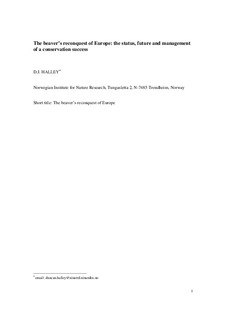| dc.description.abstract | Overhunting reduced Eurasian Beaver (Castor fiber) populations to c. 1200 animals, in eight isolated populations, around the end of the 19th century. Protection, natural spread and reintroductions led to a powerful recovery in both range and populations during the 20th century, which continues at a rapid pace. The minimum population estimate is 593 000. There are also c. 12 500 North American Beaver (C. canadensis) established in Finland and Russian Karelia; however, other populations of C. canadensis introduced in Austria, Poland and France ap-pear to be extinct. Castor fiber is now established throughout Europe with the exception of the British Isles, Iberia, Italy and the southern Balkans; reintroductions are continuing. Considerable further expansion in range and population, especially in western Europe and the lower Danube basin, can be expected. If current trends continue, C. fiber will, within a few decades, be a fairly common mammal in much of Europe. Following initial recolonization, populations typically show a pattern of rapid range extension within a watershed, followed only later by rapid population growth, and a barrier effect of watershed divides, which can be strongly isolating where physical or habitat barriers (such as mountains or intensive farmland) intrude between watersheds. Management of beaver distribution should therefore operate at the watershed scale, except where large human-made dams form significant bar-riers to spread. The period of rapid population increase, if unchecked, leads to a phase of population decline as marginal habitats are occupied and exhausted. This coincides with a peak in conflicts with human land-use interests. A regulated hunting take of healthy beaver populations is recommended as the optimal management regime in managed landscapes. Early provision of interpretation and public viewing opportunities has been a feature of several recent reintroductions. This provides a benefit to the local economy through wildlife tourism, and helps foster positive attitudes to beavers. | |
